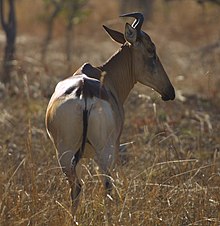Lichtenstein's hartebeest
| Lichtenstein's hartebeest | |
|---|---|

| |
| Lichtenstein's hartebeest, Zambia | |
| Scientific classification | |
| Domain: | Eukaryota |
| Kingdom: | Animalia |
| Phylum: | Chordata |
| Class: | Mammalia |
| Order: | Artiodactyla |
| Family: | Bovidae |
| Subfamily: | Alcelaphinae |
| Genus: | Alcelaphus |
| Species: | A. b. lichtensteinii
|
| Binomial name | |
| Alcelaphus buselaphus lichtensteinii Peters, 1849
| |
| Synonyms | |
|
Sigmoceros lichtensteinii | |
Lichtenstein's hartebeest (Alcelaphus buselaphus lichtensteinii)[2] is a subspecies of the hartebeest antelope that dwells in savannahs and floodplains of Southeastern[3]-Central Africa. It is sometimes classified as a unique species Sigmoceros lichtensteinii.
It typically stands about 1.25 m (4.1 ft) at the shoulder and have a mass of around 150 kg (330 lb). It has a red brown colour, which is lighter on the underbelly. The horns found on both sexes appear from the side to be shaped like the letter 'S', and appear from the front to be shaped like the letter 'O' with its upper portions missing. The horns are slightly ridged and reach over 0.5 m (1.6 ft) in length.
They live on areas where they eat grasses. They are diurnal (active in the day). They gather in herds of five to 15 females and calves with a single male, which leads them. The male stands sentry duty on termite mounds and the like. Males hold large territories, which they mark by digging up soil with their horns around the borders. Lichtenstein's hartebeest have good eyesight but a poor sense of smell. Their main sounds are a bellow and a sneeze-snort sound.
It derives its name from zoologist Martin Lichtenstein.
References
- ^ Template:IUCN2008 Database entry includes a brief justification of why this species is of least concern
- ^ Wilson, Don E. & Reeder, DeeAnn M. (editors). 2005. Mammal Species of the World. A Taxonomic and Geographic Reference (3rd ed), Johns Hopkins University Press, 2,142 pp. Available online
- ^ Selous, F. C. (2011). "XXV". Travel and Adventure in South-East Africa. New York: Cambridge University Press. p. 445. ISBN 978-1108031165.

